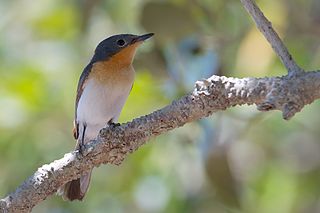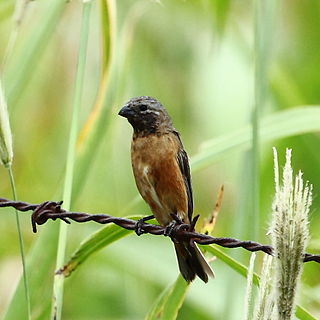
The red-breasted goose is a brightly marked species of goose in the genus Branta from Eurasia. It is currently classified as vulnerable by the IUCN.

The little grebe, also known as dabchick, is a member of the grebe family of water birds. The genus name is from Ancient Greek takhus "fast" and bapto "to sink under". The specific ruficollis is from Latin rufus "red" and Modern Latin -collis, "-necked", itself derived from Latin collum "neck".

The brown-necked raven is a larger bird than the carrion crow though not as large as the common raven. It has similar proportions to the common raven but the bill is not so large or deep and the wings tend to be a little more pointed in profile. The head and throat are a distinct brownish-black giving the bird its English name, while the rest of the plumage is black glossed with purple, blue or purplish-blue. Like the Common raven, Thick-billed raven and White-necked raven, it is one of the larger raven species. The smaller raven species are the Australian raven, Forest raven, Little raven, Fan-tailed raven and Chihuahuan raven with the Thick-billed raven being the world's largest raven species and the Chihuahuan raven being the smallest. The feathers of this species often fade quite quickly to a brownish black and the bird can look distinctly brown by the time it moults. The feet, legs and bill are black. The dwarf raven was formerly considered a subspecies but this bird now appears to be closer to the pied crow than this species.

The red-throated wryneck is a species of wryneck in the woodpecker family. It is also known as the rufous-necked wryneck, red-breasted wryneck, African wryneck or rufous-throated wryneck.

The red-necked stint is a small migratory wader. The genus name is from Ancient Greek kalidris or skalidris, a term used by Aristotle for some grey-coloured waterside birds. The specific ruficollis is from Latin rufus, "red" and collum, "neck".

The red-necked nightjar is the largest of the nightjars occurring in Europe. It breeds in Iberia and north Africa, and winters in tropical west Africa.

The southern rough-winged swallow is a small swallow. It was first formally described as Hirundo ruficollis by French ornithologist Louis Vieillot in 1817 in his Nouveau Dictionnaire d'Histoire Naturelle.

The dama gazelle, addra gazelle, or mhorr gazelle is a species of gazelle. It lives in Africa in the Sahara desert and the Sahel. This critically endangered species has disappeared from most of its former range due to overhunting and habitat loss, and natural populations only remain in Chad, Mali, and Niger. Its habitat includes grassland, shrubland, semi-deserts, open savanna and mountain plateaus. Their diets includes grasses, leaves, shoots, and fruit.

The tawny-throated dotterel is a species of bird in the Charadriidae family. It is placed in the genus Oreopholus, which is monotypic as regards living species. A prehistoric relative, Oreopholus orcesi, has been described from fossil remains.

The rufous-necked snowfinch is a species of bird in the sparrow family.

The broad-billed flycatcher is a species of bird in the family Monarchidae. It is found in northern Australia, the Lesser Sunda Islands and southern New Guinea. Its natural habitats are subtropical or tropical moist lowland forest, subtropical or tropical mangrove forest, and subtropical or tropical moist montane forest.

The streak-breasted scimitar babbler is a species of bird in the Timaliidae family.

The dark-throated seedeater is a bird species in the family Thraupidae. It is found in Argentina, Bolivia, Brazil, Paraguay, and Uruguay.

The red-throated thrush is a passerine bird in the thrush family. It is sometimes regarded as one subspecies of a polytypic species, "dark-throated thrush", black-throated thrush then being the other subspecies. More recent treatments regard the two as separate species. The scientific name comes from Latin. Turdus is "thrush" and the specific ruficollis is derived from rufus', "red", and collum, "neck".

The Somali crow, or dwarf raven, is approximately the size of the carrion crow, Corvus corone but with longer bill and somewhat more brownish cast to the feathers, especially when worn.
Tragocephalini is a tribe of longhorn beetles of the Lamiinae subfamily. It was described by Thomson in 1857.
The tricolored grebe is a bird in the Podicipedidae family sometimes considered conspecific with the little grebe. It is native to maritime Southeast Asia and Australasia. The IOC has split the bird, however other taxonomic authorities still consider the birds conspecific.
Mimolagrida is a genus of longhorn beetles of the subfamily Lamiinae, containing the following species:
Mimolagrida rufa is a species of beetle in the family Cerambycidae. It was described by Stephan von Breuning in 1947. It is known from Madagascar.
Mimolagrida rufescens is a species of beetle in the family Cerambycidae. It was described by Stephan von Breuning in 1947. It is known from Madagascar.

















